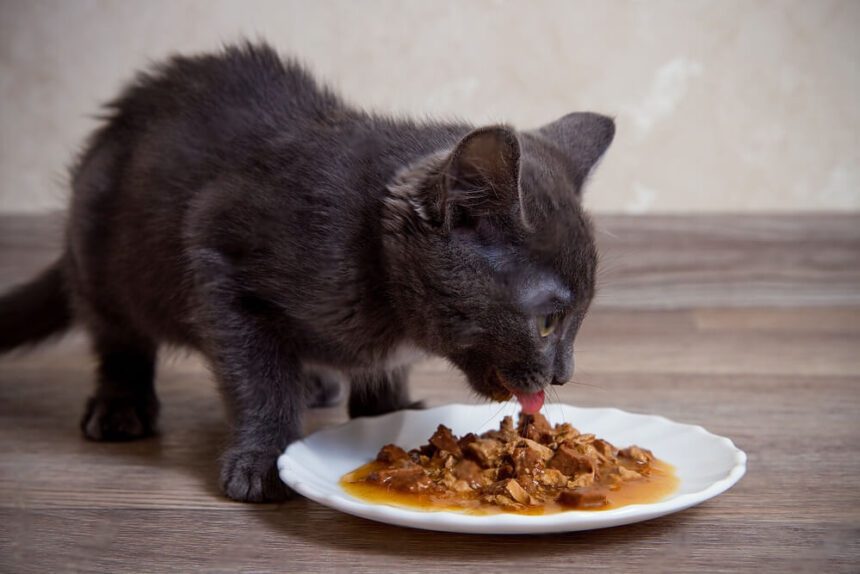A common question that arises when feeding cats is: Can cats eat cold wet food? The short answer is yes.
Cold wet food has become a topic of interest among cat owners looking to offer their pets something different, especially during scorching summer months.
As a cat owner and a passionate researcher for cat welfare, I’ve shed some light on whether it’s safe or beneficial to serve cold food to your furry friend.
In this article, I’ll tackle this intriguing question, exploring the pros and cons of serving cold wet food to feline companions. Keep on reading to understand the ins and outs of feeding our feline companions cold wet food.
Why Consider Cold Wet Food?
First things first, why would you even think about serving cold wet food to your cat? There are a few scenarios where this might come into play:
- Hot Weather: On scorching summer days, a chilled meal might be a refreshing treat for your cat.
- Convenience: Sometimes, you’re in a rush, and taking food out of the fridge without warming it can save time.
- Preferences: Believe it or not, some cats actually prefer their food cold. Each kitty has its own quirky tastes!
But let’s not just stick to the surface. Let’s dive deeper.
Can Cats Eat Cold Wet Food?
Yes, cats can eat cold wet food. In fact, some cats prefer it chilled, especially during hot weather. Cold wet food is safe and nutritious for your feline friend.
It can be a refreshing option in the summer months. Just make sure it’s not too cold, as extreme temperatures may affect their sensitive teeth.
Always prioritize your cat’s comfort and preferences when serving their meals.
Feeding your cat cold wet food from the fridge won’t harm them, but numerous studies suggest that cats generally prefer their food slightly warmed. If your cat doesn’t mind eating it cold, you’re in luck.
However, there are a few important things to keep in mind:
Temperature Matters
It’s important to consider the temperature. Food that’s too cold can be a shock to their system and might not be very appealing. Ideally, the food should be around room temperature or slightly chilled, but not ice-cold. Extreme cold can affect their sensitive teeth and might make the food less palatable.
Freshness Counts
Whenever you’re serving wet food, whether it’s cold or not, freshness is key. Wet food should not be left out for too long, as it can spoil quickly. If your cat doesn’t finish their meal, make sure to refrigerate the leftovers promptly.
Check for Allergies: Some cats may be sensitive, so monitor for any adverse reactions.
Observe Your Cat
Always keep an eye on your cat’s reaction. Some cats might have a sensitive stomach and could react poorly to cold food. If you notice any signs of discomfort or digestive issues, it might be best to warm the food slightly before serving.
Can Cold Food Make Cats Sick?
Typically, cold food won’t make a cat sick, but there are some caveats. If the food is extremely cold, it might cause temporary discomfort or a mild stomach upset. However, if your cat has any pre-existing health conditions or is very young or old, it’s best to be cautious.
Health Considerations
- Dental Sensitivity: Extremely cold food can be harsh on a cat’s teeth, especially if they have dental issues.
- Digestive Health: If your cat has a sensitive stomach, cold food might exacerbate issues like vomiting or diarrhea.
Always prioritize your cat’s health and comfort. If you’re unsure, consult with your vet to see what’s best for your specific situation.
Is Cold Wet Food Bad For Cats?
No, cold wet food is not inherently bad for cats. Many cats enjoy it, especially during warm weather. However, ensure it’s not excessively cold to prevent discomfort.
Always consider your cat’s preferences and comfort level. If you notice any issues, consult a vet for advice. Your cat’s well-being is the top priority.
Why Does My Cat Like Cold Food?
You might be wondering, why does my cat like cold food? Here are a few reasons:
Personal Preference
Just like humans, cats have their own unique preferences. Some might enjoy the texture and taste of cold food.
Soothing Effect
For cats with dental issues, cold food might have a soothing effect on their gums.
Hot Weather
In hot weather, cold food can be a refreshing change, helping your cat stay cool.
Can Kittens Eat Cold Food?
Kittens can eat cold food, but it’s generally not recommended. Their digestive systems are still developing, and they might have a harder time processing cold food. It’s best to serve kittens’ food at room temperature or slightly warm to ensure they’re getting the nutrients they need.
How To Feed My Cat Cold Food Safely?
Alright, so you’re convinced to give cold wet food a try. How can you do it safely? Here are some tips:
1. Freeze The Food
Freezing the food might be a decent option if you’re looking to serve your cat cold food for some reason. If leaving the food out to warm up isn’t an option and giving warm, wet food upsets your cat’s stomach, freezing could be a solution. You can then thaw and gently warm up small portions of the wet food as needed
2. Warm It Up With Water
If you’re in a rush, you can warm the food with a bit of warm water. This helps bring the temperature up without cooking the food.
However, it’s important to note that cats shouldn’t drink the same water you use, as their bodies handle hydration differently when it comes to urine and feces processing.
Cats can drink water just fine, but it’s best to use distilled or bottled water when adding it to their food.
3. Let Them Eat It Cold Before They Can Warm It Up With Their Body Heat
If your cat enjoys cold food, you can let them eat it cold. Just make sure it’s not too cold and that they don’t have any adverse reactions. Under no circumstances should you leave a bowl of cold wet food out for your cat. You could put it in the refrigerator, but you should only do that if you plan on keeping it for more than an hour.
Purina Fancy Feast Gravy Wet Cat Food Variety Pack
If your cat prefers cold food, you could serve some chilled wet food to let them adjust before offering more food later.
4. Warm The Wet Food In A Microwave Oven
You can also use a microwave to warm up the wet food, but be careful not to overheat it, as it could burn. Always keep an eye on it while heating to ensure it’s safe and doesn’t get too hot.
5. Make Your Cat Wait
If your cat is normally used to eating warm wet food, they may not like the cold option very well. It would be good to mix it up with a warm and cold option.
Then, make them wait for the second portion for about five minutes. It will give their stomach time to warm up again before they eat.
Purina Fancy Feast Medleys Adult Wet Cat Food Variety Pack
Are There Any Other Problems That Cold Wet Food Could Cause?
While cold wet food is generally safe, there are a couple of potential issues to be aware of:
1. Digestive Issues
The main problem with feeding a cat cold wet food is digesting it well enough to avoid digestive issues. If they vomit the food up, your cat may develop an upset stomach and diarrhea.
The diarrhea is usually very mild, but it is a sign that their stomachs are not being digested properly.
2. Kidney Problems
Feeding your cat cold wet food could lead to kidney issues, especially as they age. While younger cats typically have healthy kidneys and may not be affected, feeding cold food to cats over seven years old could potentially harm their kidneys.
Does Wet Cat Food Need To Be Refrigerated?
Yes, wet cat food should be refrigerated to keep it fresh. Once opened, it should be stored in the fridge and used within a few days. However, your cat’s digestive system benefits from slightly warmed food. While some cats prefer cold wet food, you can serve it chilled without the need to heat it up, depending on your cat’s preference.
Sheba Perfect Portions Cuts in Gravy Wet Cat Food Trays
Should You Warm Up Refrigerated Cat Food?
While it’s not strictly necessary, warming up refrigerated cat food can make it more appealing to your cat. As mentioned earlier, you can use the microwave for about 5 minutes to gently warm the food.
There is usually a warming setting on microwaves specially designed to heat cat food. You can also heat the bowl of wet cat food over a pot of boiling water while you feed them another meal.
Chilled wet food could also cause a problem if your cat eats too quickly because it will not be able to digest the water properly.
Should Cats Eat Warm Or Cold Wet Food?
The answer to this depends on your cat’s preferences. Some cats prefer warm food, while others might enjoy it cold. The key is to observe your cat and see what they like best. You can also mix it up to keep their meals interesting.
Should I Warm Up My Cat’s Wet Food?
If your cat seems to prefer warm food, go ahead and warm it up. Just be careful not to make it too hot. The goal is to take the chill off, not to cook the food.
Do Cats Like Cold Food or Warm Food?
This really comes down to individual preference. Some cats might love cold food, especially in hot weather, while others might prefer their food warm. Try both and see what your cat enjoys.
FAQ
Can I Give My Cat Cold Wet Food?
The short answer to this question is yes. You can give your cat cold wet food as long as you are careful to make sure that they do not vomit up the food.
It is not advised to feed them cold, wet food more than once a week because it could cause digestive issues.
Can Cats Eat Refrigerated Wet Food?
Yes, cats can eat refrigerated wet food if it is heated first. Simply place the dry cat food into a microwave and heat it for about 5 minutes. You can then place the warm bowl of wet dog food in front of your cat and let them eat with no problems at all.
Can Cat Eat Cold Canned Food?
Yes, cats can eat cold canned food. However, they must not be given cold wet food because it could cause them to vomit up their food and have digestive problems. If you plan to give them cold, wet food, you should make sure that they eat the food slowly so that their body temperature can rise.
Are Wet Cat Foods Good For Your Cat?
Yes, wet cat foods are very good for your cat, especially if your pet has dry skin issues. They also contain more moisture than dry food, which is very good for cats because it will help prevent dehydration. It would be best if you still kept an eye on your cat’s weight, though.
When To Feed Dry And Wet?
You should not feed your cat both dry and wet foods simultaneously regularly because this will cause them to suffer from diarrhea and vomiting problems.
Can I serve cold wet food straight from the refrigerator?
Yes, you can serve cold wet food directly from the refrigerator, but make sure it’s not too cold. Let it sit at room temperature for a short while to take the chill off.
Is cold wet food more nutritious than dry kibble?
Both cold wet food and dry kibble have their merits. Cold wet food is higher in moisture, which can be beneficial for your cat’s hydration, while dry kibble provides dental benefits.
How Do I Warm Cold Wet Food if My Cat Prefers It That Way?
You can gently warm cold wet food by placing it in a microwave-safe dish and heating it for a few seconds. Stir well and check the temperature before serving.
Can Cold Wet Food Be a Part of My Cat’s Daily Diet?
Yes, cold wet food can be a regular part of your cat’s diet as long as it meets their nutritional needs and doesn’t cause any digestive issues.
Final Thoughts
So, Can Cats Eat Cold Wet Food? Absolutely, they can. Whether it’s a hot summer day or just a matter of preference, cold wet food can be a viable option for your feline friend. Just remember to monitor their reaction and make adjustments as needed. Your cat’s comfort and health should always come first.
By following these tips and best practices, you can ensure that your cat enjoys a delicious and nutritious meal, no matter the temperature. Happy feeding, and may your kitty always purr with contentment!
Feel free to drop any questions or share your own experiences in the comments. Let’s keep our feline friends happy and healthy together!



